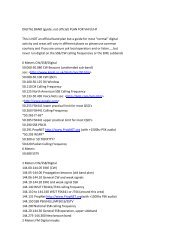You also want an ePaper? Increase the reach of your titles
YUMPU automatically turns print PDFs into web optimized ePapers that Google loves.
<strong>PSK</strong>31 Operating Hints and Tips:<br />
One of the best beginner (and veteran use) <strong>PSK</strong>31 programs is Win<strong>PSK</strong> by Moe Wheatley AE4JY. Up front,<br />
the program is so easy to understand. It’s straight-forward display exposes defined icons and mouse-over brief<br />
explanations of each icon.<br />
Perhaps the flair that makes Win<strong>PSK</strong> excel is the very well written users support document, also written by<br />
Moe. Not only is Moe talented at writing code and building software, he has the a gift to build the<br />
documentation to support his code and software. I can attest to the fact that it takes the “right-stuff” for a<br />
software writer to describe how to use and apply the code he/she has written. You will more fully understand<br />
when you begin using the latest version of Win<strong>PSK</strong>.<br />
The best way to become familiar with Win<strong>PSK</strong> is to start playing with it and clicking away on things. In actual<br />
operation, learning to use the left, right, arrow keys for moving to the receive signal frequency is very handy.<br />
There usually is never a need to touch the mouse to be able to tune in a <strong>PSK</strong>31 signal.<br />
The actual Transmit/Receive frequency is your USB radio dial frequency setting plus the audio frequency<br />
displayed in Win<strong>PSK</strong>. If using LSB, you subtract the audio frequency from your dial setting. For example if<br />
your transceiver is in the USB mode and reads 14070.00 KHz and your audio frequency is 1500 Hz, then your<br />
actual transmit/receive frequency is 14071.50 KHz.<br />
The TX and RX frequencies are limited between 200 and 3500 Hz.., however it is best to stay away from the<br />
edges because transmitters may have some frequency limitations as well as some soundcards. (This may<br />
explain some of the weird asymmetric signals observed from time to time )<br />
Don't send all your text as UPPER CASE letters. <strong>PSK</strong>31 was designed to send the most commonly used letters<br />
such as 'e' and 't' much faster than lesser used letters such as 'z'. Uppercase letters take a LOT longer to send<br />
and just slow down your transmission. Type as you would normally and capitalize letters as needed. A<br />
common practice is to send callsigns in upper case. Win<strong>PSK</strong> converts your call and "Theircall" to upper case<br />
automatically when using macros.<br />
Make sure your PC time and date are set correctly. Win<strong>PSK</strong> assumes your PC's date, time, and time zone<br />
settings are correct.<br />
If you need more screen area, go to the View menu and un check the toolbar and status bar views. This will<br />
give a bit more area for the program. Adjust the screen size so the bottom part of the screen does not have a<br />
scroll bar since that wastes room as well. Also if try using the small display fonts option in the Window's<br />
Display Setup.<br />
Use the drag and drop capability of Win<strong>PSK</strong> with care. Dragging text into the transmit edit<br />
box while transmitting or into the middle of the transmitted text is asking for trouble. It's best to do<br />
all the "dragg’n and drop’n" BEFORE starting a transmission. The same goes for pasting text<br />
from the clipboard into the TX text window while transmitting. If you must do it, make sure you<br />
paste at the end of the text.<br />
Try using the Q<strong>PSK</strong> mode when conditions get rough. In many circumstances, using Q<strong>PSK</strong> will greatly<br />
improve reception due to it's error correcting capability. Win<strong>PSK</strong> was designed to tune in Q<strong>PSK</strong> signals as<br />
easily as B<strong>PSK</strong>.<br />
IMD measurements are only guidelines at best. They are ONLY valid when the incoming signal is VERY<br />
strong, only during several seconds of <strong>PSK</strong>31 "idle" transmission, and the propagation path is free of QSB.<br />
12<br />
VISIT: www.BUXcommco.com



